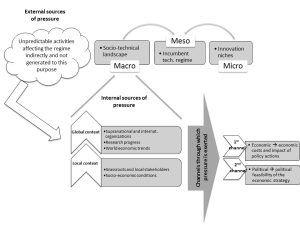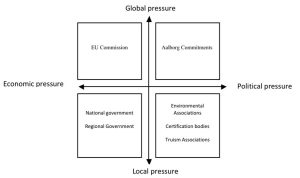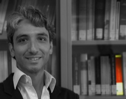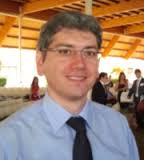49
Piergiuseppe Morone, Unitelma-Sapienza University of Rome, and Antonio Lopolito, University of Foggia, Italy
Introduction
In this post we look at drivers for a sustainable waste management transition using the multi-level perspective (MLP, Rip and Kemp, 1998; Geels, 2002) and developing a new conceptual framework to assess landscape sources of pressure upon the socio-technical regime. In a recent paper we developed a pressure matrix – i.e. a tool for policy analysis that can be used to assess and classify the key sources of pressure to bring about the desired transition – to which we refer in this blog-post (Morone et al., 2015).
According to the MLP, a socio-technical transition might occur if the socio-technical landscape (i.e. the ‘macro level’) exerts sufficient pressure on the incumbent technological regime (i.e. the ‘meso level’) and if this pressure is matched by the ‘full development’ of at least one innovation niche (i.e. the ‘micro level’). This alignment might ultimately determine conditions to allow a new technology to replace the incumbent regime.
Existing literature has dedicated much effort to understand and define innovation niches [1]. However, the macro level has not been properly investigated yet, and its definition remains vague and perhaps somewhat narrow, as it refers mainly to an exogenous context (demographical trends, political ideologies, societal values, and macro-economic patterns) that actors at niche and regime levels cannot influence in the short run.
In our current research (Dellino et al., 2015) we are trying to push our understanding of the landscape level one step ahead, proposing a taxonomy of actors acting at this level. The proposed classification is functionally-driven, meaning that we identify landscape actors by focusing on the activities that produce the pressure sources.
Bearing this in mind, we start considering two sources of pressure at the macro level: external and internal. The former is exerted by completely unpredictable activities (i.e. events affecting the regime incidentally and not generated to this purpose), which act on the system as exogenous shocks – e.g. earthquakes, wars, etc. On the contrary, internal pressure activities are deliberately exerted by stakeholders in order to induce a misalignment of some landscape factors from the socio-technical regime. Note that internal pressure activities can also be induced by external shocks, being in this sense a derived source of pressure or ‘second-level’ landscape source of pressure.
In our investigation we decide to focus on this latter source, suggesting the following classification: internal pressure may be exerted from both local (e.g. grassroots associations) and global actors (e.g. supranational organizations, world economic developments and trends); further, global and local actors might act through political and/or economic channel.
Often, a combination of different channels and sources is required for the overall pressure to be most effective. An unbalanced pressure (i.e. coming only from one channel or one source) can be ineffective since even a strong political pressure, if decoupled from a sufficient economic support, can result unable to produce the right amount of pressure upon the regime technology, and vice versa. The idea of unbalanced pressure relates to the ‘complex contagion’ concept first proposed by Centola and Macy (2007). A complex contagion requires social affirmation from multiple sources and refers to the spread of collective behaviours that involve social reinforcement from multiple contacts. Having all these elements in mind, the methodological framework of our analysis is summarised in figure 1.

In order to investigate landscape sources of pressure on the socio-technical regime, we focused upon the case of urban waste management. Efficient urban waste management systems (WMSs) should aim at reducing or avoiding waste generation by developing or changing production and consumption patterns.
Separate waste collection is a key tool in this regard, allowing both an efficient management of the disposed of materials (re-use and recycle), and a reduction in the overall amount of waste disposed of into the environment. In this management framework, once separated from other materials, organic waste can go through a valorisation process, which involves the recovery of fine chemicals and the production of precious metabolites via chemical and biotechnological processes.
Recalling now the proposed taxonomy, we use it to identify direct sources of pressure occurring at the landscape level for a transition towards a sustainable WMS. In particular, we aim at identifying all possible actors operating at the landscape level and exercising pressure upon local municipalities involved in urban waste management. By means of six case-studies, we (i) performed a stakeholders’ analysis, aimed at identifying the key landscape actors exerting pressure, and (ii) explored economic and political pressures exerted at both local and global level.

Our case studies focus on the analysis of the WMSs in the province of Foggia, (Apulia region, southeast of Italy – see figure 2), which is the second largest Italian province with an extension of approximately 7,000 km2. In particular, we chose six municipalities that were recognised as “best practices” in implementing an efficient WMS within the province of Foggia in 2013 and attempt to identify the most relevant landscape sources of pressure that induced virtuous behaviours in these local municipalities.
Based on interviews with experts and on existing literature,[2] the following actors were identified and classified (Table 1):
Table 1: Landscape actors exerting pressure
| Actors | Role |
| Regional government | Setting environmental regulations and standards, monitoring and enforcement at regional/local level. |
| National government, EU Commission | Policy guidance with long term view in allocating resources. |
| Environmental Associations | Mobilizing community participation, voicing local concern. |
| Environmental certification bodies | Demonstration of compliance to environmental standards, a code of practice or regulatory requirements. |
| Tourism associations | Channelling tourism flows; providing a voice on issues of common interest related to tourism. |
| Public (e.g. Aalborg commitments) | Participation in decision-making, implementation and monitoring of policy actions. |
We then framed them into a pressure matrix which allows us to classify stakeholders into four groups: (1) global actors exerting pressure through the economic channel; (2) global actors exerting pressure through the political channel; (3) local actors exerting pressure through the economic channel; (4) local actors exerting pressure through the political channel (Figure 3).

Wrapping up
in this post drivers for a sustainable waste management transition are analysed through the lenses of the multi-level perspective. The focus is on the higher level – i.e. the socio-technical landscape – exerting pressure upon the dominant technological regime. This pressure is exerted by actors both at global and local level (i.e. sources) through economic and political channels (i.e. channels). Combining this two dimensions we develop a pressure matrix directed at assessing and classify the key sources of pressure. Proving that a balanced combination of different channels and sources is required for the overall pressure to be most effective, this matrix represent a tool for policy analysis that can be used to identify weak and strong areas of pressure, defining the consequent policy actions to be undertaken to bring about the desired transition.
References
Centola, D. and Macy M. (2007) ‘Complex contagions and the weakness of long ties’. American Journal of Sociology 113 (3), 702-734.
Dellino, G., C. Meloni, P. Morone, V. Tartiu (2015). ‘Sustainability transitions in multipurpose biorefineries’. Mimeo.
Geels, F.W. (2002) ‘Technological transitions as evolutionary reconfiguration processes: a multi-level perspective and a case-study’. Research Policy Vol. 31, pp. 1257–1274.
Joseph, K. (2006). ‘Stakeholder participation for sustainable waste management’. Habitat International, 30 (4) (2006), pp. 863–871.
Kemp, R., Schot, J.W., Hoogma, R. (1998). ‘Regime shifts to sustainability through processes of niche formation: the approach of strategic niche management’. Technology Analysis and Strategic Management 10, 175–196.
Lopolito, A., Morone, P., Sisto, R. (2011). ‘Innovation niches and socio-technical transition: a case study of bio-refinery production’. Futures 43 (1), 24–38.
Morone, P., A. Lopolito, E. Sica and V. E. Tartiu (2015). ‘Sources of change: unpacking landscape pressures on socio-technical regimes. Insights from the urban waste management system’. Mimeo.
Rip, A., Kemp, R. (1998). ‘Technological change’. In: Rayner, S., Malone, E.L. (Eds.), Human Choice and Climate Change, 2. Battelle Press, Columbus, OH, pp. 327–399.
Smith, A., Raven, R. (2012). ‘What is protective space? Reconsidering niches in tran- sitions to sustainability’. Research Policy 41 (6), 1025–1036.
[2] We draw significantly on the classification proposed by Joseph (2006).
Author Biographies
Piergiuseppe Morone is an economist with an interest in evolutionary theory applied especially to sustainable innovation studies. As a postgraduate student he was trained at SPRU-Sussex University where he received in 2003 his PhD in Science & Technology Policy with a thesis on innovation economics, investigating the relation between social network architectures and speed of diffusion of knowledge and innovations. He is now a Professor of Political Economy at Unitelma Sapienza – University of Rome with a strong interest in green innovation and sustainability transitions pushing his research at the interface between innovation, agricultural economics and chemistry, an area of enquiry that has attracted growing attention among social scientists over the last decade. He is vice-chair and Management Committee member of the Cost Action TD1203 on Food waste valorisation and recently he joined Editorial Advisory Board of Open Agriculture, open access journal by De Gruyter Open.
Contact email: piergiuseppe.morone@unitelma.it
Antonio Lopolito is Assistant Professor of Agricultural Economics at the Department of Agricultural Sciences of the University of Foggia. He completed his Ph.D. in “Sustainable Agricultural Systems” at the University of Foggia, defending a thesis in which proposed a method to evaluate the production of social capital by European Rural Development Policy at a local level. Later, he developed a comprehensive evaluation tool, accounting both for tangible and intangible outputs of Local Action Groups within the LEADER Initiative. His main research interests focuses on behaviors spread through social networks and on agents’ expectations convergence. A first line of research uses agent based models to understand how social networks dynamics can impact the spread of new behaviors or novelties. He uses also field experiments to analyzes how a shared vision can emerges among agents. His research activity has given rise to a tens of scientific articles published in several international indexed scientific journals.
Contact email: antonio.lopolito@gmail.com


